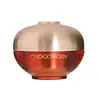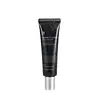What's inside
What's inside
 Key Ingredients
Key Ingredients

 Benefits
Benefits

 Concerns
Concerns

 Ingredients Side-by-side
Ingredients Side-by-side

Phellinus Linteus Extract
Skin ConditioningButylene Glycol
HumectantButyrospermum Parkii Butter
Skin ConditioningHydrogenated Poly(C6-14 Olefin)
EmollientWater
Skin ConditioningDimethicone
EmollientLimnanthes Alba Seed Oil
Skin ConditioningPentaerythrityl Tetraethylhexanoate
EmollientBehenyl Alcohol
EmollientNiacinamide
SmoothingStearyl Alcohol
EmollientCyclopentasiloxane
EmollientPentylene Glycol
Skin ConditioningPolyglyceryl-3 Methylglucose Distearate
EmulsifyingHydroxypropyl Starch Phosphate
Potassium Cetyl Phosphate
EmulsifyingCyclohexasiloxane
Emollient1,2-Hexanediol
Skin ConditioningChondrus Crispus Extract
Skin ConditioningChlorella Vulgaris Extract
Skin ConditioningSaccharum Officinarum Extract
MoisturisingTheobroma Cacao Seed Extract
AntioxidantCandida Bombicola/Glucose/Methyl Rapeseedate Ferment
AntimicrobialVincetoxicum Atratum Extract
Skin ConditioningPanax Ginseng Root Extract
EmollientSoluble Collagen
HumectantAngelica Gigas Extract
Skin ConditioningCornus Officinalis Fruit Extract
Skin ConditioningThymus Vulgaris Extract
PerfumingVelvet Extract
HumectantMacadamia Ternifolia Seed Oil
EmollientAlthaea Rosea Flower Extract
Skin ConditioningHelianthus Annuus Seed Oil
EmollientGlyceryl Stearate
EmollientDiisostearyl Malate
EmollientSilica
AbrasiveAcrylates/C10-30 Alkyl Acrylate Crosspolymer
Emulsion StabilisingGlucose
HumectantCaprylyl Glycol
EmollientCetearyl Glucoside
EmulsifyingFructooligosaccharides
HumectantFructose
HumectantPotassium Hydroxide
BufferingGlycerin
HumectantDipotassium Glycyrrhizate
HumectantAdenosine
Skin ConditioningSodium Phytate
Dextrin
AbsorbentEthylhexylglycerin
Skin ConditioningPolyglyceryl-10 Pentastearate
Skin ConditioningSodium Stearoyl Glutamate
CleansingCetearyl Alcohol
EmollientCI 77891
Cosmetic ColorantPhenoxyethanol
PreservativeParfum
MaskingBenzyl Salicylate
PerfumingAlpha-Isomethyl Ionone
PerfumingCitronellol
PerfumingGeraniol
PerfumingLinalool
PerfumingLimonene
PerfumingHydroxycitronellal
PerfumingHexyl Cinnamal
PerfumingMica
Cosmetic ColorantPhellinus Linteus Extract, Butylene Glycol, Butyrospermum Parkii Butter, Hydrogenated Poly(C6-14 Olefin), Water, Dimethicone, Limnanthes Alba Seed Oil, Pentaerythrityl Tetraethylhexanoate, Behenyl Alcohol, Niacinamide, Stearyl Alcohol, Cyclopentasiloxane, Pentylene Glycol, Polyglyceryl-3 Methylglucose Distearate, Hydroxypropyl Starch Phosphate, Potassium Cetyl Phosphate, Cyclohexasiloxane, 1,2-Hexanediol, Chondrus Crispus Extract, Chlorella Vulgaris Extract, Saccharum Officinarum Extract, Theobroma Cacao Seed Extract, Candida Bombicola/Glucose/Methyl Rapeseedate Ferment, Vincetoxicum Atratum Extract, Panax Ginseng Root Extract, Soluble Collagen, Angelica Gigas Extract, Cornus Officinalis Fruit Extract, Thymus Vulgaris Extract, Velvet Extract, Macadamia Ternifolia Seed Oil, Althaea Rosea Flower Extract, Helianthus Annuus Seed Oil, Glyceryl Stearate, Diisostearyl Malate, Silica, Acrylates/C10-30 Alkyl Acrylate Crosspolymer, Glucose, Caprylyl Glycol, Cetearyl Glucoside, Fructooligosaccharides, Fructose, Potassium Hydroxide, Glycerin, Dipotassium Glycyrrhizate, Adenosine, Sodium Phytate, Dextrin, Ethylhexylglycerin, Polyglyceryl-10 Pentastearate, Sodium Stearoyl Glutamate, Cetearyl Alcohol, CI 77891, Phenoxyethanol, Parfum, Benzyl Salicylate, Alpha-Isomethyl Ionone, Citronellol, Geraniol, Linalool, Limonene, Hydroxycitronellal, Hexyl Cinnamal, Mica
Galactomyces Ferment Filtrate
HumectantLactobacillus/Collagen Ferment Filtrate
HumectantButylene Glycol
HumectantCaprylic/Capric Triglyceride
MaskingGlycerin
HumectantCetearyl Alcohol
EmollientCetyl Ethylhexanoate
EmollientMacadamia Integrifolia Seed Oil
Skin ConditioningWater
Skin Conditioning1,2-Hexanediol
Skin ConditioningCetearyl Olivate
Pentylene Glycol
Skin ConditioningBifida Ferment Lysate
Skin ConditioningCeramide NP
Skin ConditioningSorbitan Olivate
EmulsifyingSorbitan Stearate
EmulsifyingPropanediol
SolventBetaine
HumectantPanthenol
Skin ConditioningSodium Hyaluronate
HumectantAloe Barbadensis Leaf Extract
EmollientAlthaea Rosea Root Extract
HumectantBeta-Glucan
Skin ConditioningCopper Tripeptide-1
Skin ConditioningPalmitoyl Pentapeptide-4
Skin ConditioningPalmitoyl Tripeptide-1
Skin ConditioningHexapeptide-11
Skin ConditioningHexapeptide-9
Skin ConditioningTripeptide-1
Skin ConditioningAllantoin
Skin ConditioningAcrylates/C10-30 Alkyl Acrylate Crosspolymer
Emulsion StabilisingIsopentyldiol
HumectantArginine
MaskingSucrose Palmitate
EmollientSodium Surfactin
CleansingAdenosine
Skin ConditioningCaprylyl Glycol
EmollientCitrus Paradisi Fruit Extract
Skin ConditioningTocopherol
AntioxidantSchisandra Chinensis Fruit Extract
Skin ConditioningPerilla Ocymoides Leaf Extract
TonicAcorus Calamus Root Extract
PerfumingPolyglyceryl-10 Laurate
Skin ConditioningGalactomyces Ferment Filtrate, Lactobacillus/Collagen Ferment Filtrate, Butylene Glycol, Caprylic/Capric Triglyceride, Glycerin, Cetearyl Alcohol, Cetyl Ethylhexanoate, Macadamia Integrifolia Seed Oil, Water, 1,2-Hexanediol, Cetearyl Olivate, Pentylene Glycol, Bifida Ferment Lysate, Ceramide NP, Sorbitan Olivate, Sorbitan Stearate, Propanediol, Betaine, Panthenol, Sodium Hyaluronate, Aloe Barbadensis Leaf Extract, Althaea Rosea Root Extract, Beta-Glucan, Copper Tripeptide-1, Palmitoyl Pentapeptide-4, Palmitoyl Tripeptide-1, Hexapeptide-11, Hexapeptide-9, Tripeptide-1, Allantoin, Acrylates/C10-30 Alkyl Acrylate Crosspolymer, Isopentyldiol, Arginine, Sucrose Palmitate, Sodium Surfactin, Adenosine, Caprylyl Glycol, Citrus Paradisi Fruit Extract, Tocopherol, Schisandra Chinensis Fruit Extract, Perilla Ocymoides Leaf Extract, Acorus Calamus Root Extract, Polyglyceryl-10 Laurate
 Reviews
Reviews

Ingredients Explained
These ingredients are found in both products.
Ingredients higher up in an ingredient list are typically present in a larger amount.
1,2-Hexanediol is a synthetic liquid and another multi-functional powerhouse.
It is a:
- Humectant, drawing moisture into the skin
- Emollient, helping to soften skin
- Solvent, dispersing and stabilizing formulas
- Preservative booster, enhancing the antimicrobial activity of other preservatives
Acrylates/C10-30 Alkyl Acrylate Crosspolymer is a synthetic polymer. It is used to thicken and improve the texture of products. Due to its properties, it can prevent water and oil ingredients from separating.
Adenosine is in every living organism. It is one of four components in nucleic acids that helps store our DNA.
Adenosine has many benefits when used. These benefits include hydrating the skin, smoothing skin, and reducing wrinkles. Once applied, adenosine increases collagen production. It also helps with improving firmness and tissue repair.
Studies have found adenosine may also help with wound healing.
In skincare products, Adenosine is usually derived from yeast.
Learn more about AdenosineButylene Glycol (or BG) is used within cosmetic products for a few different reasons:
Overall, Butylene Glycol is a safe and well-rounded ingredient that works well with other ingredients.
Though this ingredient works well with most skin types, some people with sensitive skin may experience a reaction such as allergic rashes, closed comedones, or itchiness.
Learn more about Butylene GlycolCaprylyl Glycol is a humectant and emollient, meaning it attracts and preserves moisture.
It is a common ingredient in many products, especially those designed to hydrate skin. The primary benefits are retaining moisture, skin softening, and promoting a healthy skin barrier.
Though Caprylyl Glycol is an alcohol derived from fatty acids, it is not the kind that can dry out skin.
This ingredient is also used as a preservative to extend the life of products. It has slight antimicrobial properties.
Learn more about Caprylyl GlycolCetearyl alcohol is a mixture of two fatty alcohols: cetyl alcohol and stearyl alcohol. It is mainly used as an emulsifier. Emulsifiers help prevent the separation of oils and products. Due to its composition, it can also be used to thicken a product or help create foam.
Cetearyl alcohol is an emollient. Emollients help soothe and hydrate the skin by trapping moisture.
Studies show Cetearyl alcohol is non-toxic and non-irritating. The FDA allows products labeled "alcohol-free" to have fatty alcohols.
This ingredient is usually derived from plant oils such as palm, vegetable, or coconut oils. There is debate on whether this ingredient will cause acne.
Due to the fatty acid base, this ingredient may not be Malassezia folliculitis safe.
Learn more about Cetearyl AlcoholGlycerin is already naturally found in your skin. It helps moisturize and protect your skin.
A study from 2016 found glycerin to be more effective as a humectant than AHAs and hyaluronic acid.
As a humectant, it helps the skin stay hydrated by pulling moisture to your skin. The low molecular weight of glycerin allows it to pull moisture into the deeper layers of your skin.
Hydrated skin improves your skin barrier; Your skin barrier helps protect against irritants and bacteria.
Glycerin has also been found to have antimicrobial and antiviral properties. Due to these properties, glycerin is often used in wound and burn treatments.
In cosmetics, glycerin is usually derived from plants such as soybean or palm. However, it can also be sourced from animals, such as tallow or animal fat.
This ingredient is organic, colorless, odorless, and non-toxic.
Glycerin is the name for this ingredient in American English. British English uses Glycerol/Glycerine.
Learn more about GlycerinPentylene glycol is typically used within a product to thicken it. It also adds a smooth, soft, and moisturizing feel to the product. It is naturally found in plants such as sugar beets.
The hydrophilic trait of Pentylene Glycol makes it a humectant. As a humectant, Pentylene Glycol helps draw moisture from the air to your skin. This can help keep your skin hydrated.
This property also makes Pentylene Glycol a great texture enhancer. It can also help thicken or stabilize a product.
Pentylene Glycol also acts as a mild preservative and helps to keep a product microbe-free.
Some people may experience mild eye and skin irritation from Pentylene Glycol. We always recommend speaking with a professional about using this ingredient in your routine.
Pentylene Glycol has a low molecular weight and is part of the 1,2-glycol family.
Learn more about Pentylene GlycolWater. It's the most common cosmetic ingredient of all. You'll usually see it at the top of ingredient lists, meaning that it makes up the largest part of the product.
So why is it so popular? Water most often acts as a solvent - this means that it helps dissolve other ingredients into the formulation.
You'll also recognize water as that liquid we all need to stay alive. If you see this, drink a glass of water. Stay hydrated!
Learn more about Water